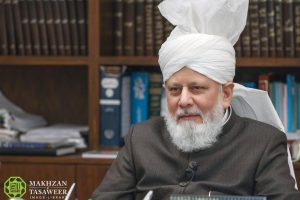The term “Islamic caliphate” stirs a fear of Islamic global political control. Some, like Sean Hannity, claim that giving control to Al – Qaeda would lead to an Islamic caliphate. Although “caliphate” is the English rendition of the Arabic term “Khilafat”, the two words have different connotations in the present age.
Whereas “caliphate” has begun to imply a political leader chosen by Muslim followers (how that choice will be made from so many sects is left unaddressed) “Khilafat” refers to the institution of spiritual successorship. The Khalifa is a successor to a prophet of God, whose goal is to continue and consolidate the tasks of reformation and moral training that the prophet instituted. Therefore, Khilafat can exist and flourish without a state.
The Islamic understanding of Khilafat is based on the Qur’an, the teachings of Muhammad(saw), the Prophet of Islam, and the examples of the first four rightly guided khalifas after the Prophet(saw)’s demise. The Prophet Muhammad(saw) prophesied that after his demise:
“Prophethood shall remain among you as long as Allah Wills. He will bring about its end and follow it with Khilafat on the precepts of prophethood. Then whenever He Wills, He shall end this blessing and a tyrannical monarchy will follow and people will face hardship and oppression. There will follow an even more oppressive era. Allah’s mercy will end this oppression, there will then emerge Khilafat on the precepts of Prophethood.”1
The first four Khalifas were termed “rightly-guided” to distinguish them from the caliph-kings who followed. The reign (632-661) of the rightly-guided Khalifas is often remembered as a golden age of Islam. After the assassination of the last of the rightly-guided Khalifas, debate over successorship resulted in a major split in Islam into Sunni and Shia branches. Spirituality was lost and replaced by a political institution, or caliphate. Muawiyyah declared himself leader of the Muslims, laying the foundations of a long line of dynastic monarchies – in accordance with Muhammad(saw)’s prophecy.
This reign of caliphs continued for centuries, until Ottoman Sultan, Selim I, captured the last caliph of Cairo in 1517. The Ottoman sultans then claimed the title of caliph and brandished it for four centuries until Kamal Ataturk abolished it in 1924.
Osama bin Laden and a number of fundamentalist political parties have called for the restoration of caliphate to unite Muslim nations – either through peaceful political uprising or through force. In addition to Hizbul Tahrir, two radical pan-Islamic groups, Jama’at-e-Islami, and the Muslim Brotherhood, seek to restore the caliphate even if it be as a militant Islamic institution.
Any attempts to impose caliphate are doomed to fail because it diverges from the true Islamic system of Khilafat, and because of the disunity among Muslims to elect a leader.
The Ahmadiyya Muslim community, however, stands out. As Muslims who believe in the Promised Messiah – Hadhrat Mirza Ghulam Ahmad(as) of Qadian, India – the community was founded in 1889 and spans over 196 countries with adherents exceeding tens of millions. Since the demise of Hadhrat Ahmad(as) in 1908, five more Khalifas have been elected, who have focused on serving the faith and reforming the faithful, as opposed to establishing a Muslim state.
The West fears it might have to one day deal with a “caliphate”. But the West is already dealing with “Khilafat” in its pure form with the Ahmadiyya Khilafat, which has existed for 122 years without any notion of a new world order or a Muslim ruler:
“For this Khilafat, neither is a violent uprising required, not are bullets needed to be fired. The reward of Khilafat can only be established with God’s Grace, and has been established through His blessings; not through the efforts and schemes of people.” (Hadhrat Mirza Masroor Ahmad(aba), Khalifatul Masih V)2
The Ahmadiyya Khilafat has always categorically rejected religious militancy in every form. When faced with bitter persecution, it practices patience and perseverance. It champions the cause of the dispossessed and oppressed. It has conquered no land and possesses no earthly dominion, but it wields its influence over the hearts and minds of millions as a force for good in the world.
So there is no need to fear the true Islamic concept of Khilafat, which does not seek any political control or the establishment of a politico-religious state. It is time for Muslims and non-Muslims to understand what Islamic “Khilafat” truly is – a system of spiritual leadership aimed at the spiritual and personal reformation of the Muslims and mankind. Hadhrat Mirza Masroor Ahmad(aba) states:
“The majority formed out of winning people’s hearts and that brings a message of love rather than compulsion, which does not act unjustly, rather spreads love; which always cooperates in matters of goodness – and as the Rightly Guided Khilafat exists to provide people their rights and establish justice – (hence) a government under such a Khilafat will safeguard the rights owed to people, rather than usurp them.”3
Today there is only one community that spans so many national boundaries and whose members owe absolute allegiance to its God-appointed leader – and that is the Ahmadiyya Muslim community, led by a Khalifa.
Endnotes
1. Musnad Ahmad
2. Friday Sermon, 25th Feb. 2011
3. Friday Sermon, 25th Feb. 2011




Add Comment